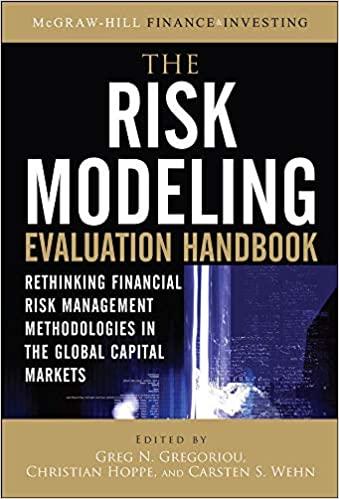Answered step by step
Verified Expert Solution
Question
1 Approved Answer
1 . Assume Venture Healthcare sold bonds that have a ten - year maturity, a 1 2 percent coupon rate with annual payments, and a
Assume Venture Healthcare sold bonds that have a tenyear maturity, a percent coupon rate with annual payments, and a $ par value.
a Suppose that two years after the bonds were issued, the required interest rate fell to percent. What would be the bond's value?
b Suppose that two years after the bonds were issued, the required interest rate rose to percent. What would be the bond's value?
c What would be the value of the bonds three years after issue in each scenario above, assuming that interest rates stayed steady at either percent or percent?
Twin Oaks Health Center has a bond issue outstanding with a coupon rate of percent and four years remaining until maturity. The par value of the bond is $ and the bond pays interest annually.
a Determine the current value of the bond if present market conditions justify a percent required rate of return.
b Now, suppose Twin Oaks' fouryear bond had semiannual coupon payments. What would be its current value? Assume a percent semiannual required rate of return. However, the actual rate would be slightly less than percent because a semiannual bond is slightly less risky than an annual coupon bond.
c Assume that Twin Oaks' bond had a semiannual coupon but years remaining to maturity. What is the current value under these conditions? Again assume a percent semiannual required rate of return, although the actual rate would probably be greater than percent because of increased price risk.
Minneapolis Health System has bonds outstanding that have four years remaining to maturity, a coupon interest rate of percent paid annually, and a $ par value.
a What is the yield to maturity on the issue if the current market price is $
b If the current market price is $
c Would you be willing to buy one of these bonds for $ if you required a percent rate of return on the issue? Explain your answer.
Six years ago, Bradford Community Hospital issued year municipal bonds with a percent annual coupon rate. The bonds were called today for a $ call premiumthat is bondholders received $ for each bond. What is the realized rate of return for those investors who bought the bonds for $ when they were issued?
Rex Healthcare recently issued a bond with a year maturity, an annual coupon rate of percent, a face value of $ and semiannual interest payments. If the current rate of interest is a percent yield to maturity on this investment, what is the current price of the bond?
A person is considering buying the stock of two home health companies that are similar in all respects except for the proportion of earnings paid out as dividends. Both companies are expected to earn $ per share in the coming year, but Company D for dividends is expected to pay out the entire amount one year from now as dividends, while Company G for growth is expected to pay out only onethird of its earnings or $ per share. The companies are equally risky, and their required rate of return is percent. Ds constant growth rate is zero and Gs is percent. What are the expected prices of Stocks D and G
Medical Corporation of America MCA has a current stock price of $ and its last dividend D was $ In view of MCA's strong financial position, its required rate of return is percent. If MCA's dividends are expected to grow at a constant rate in the future, what is the firm's expected stock price in five years?
Better Life Nursing Home, Inc., has maintained a dividend payment of $ per share for many years. The same dollar dividend is expected to be paid in future years. If investors require a percent rate of return on investments of similar risk, determine the value of the company's stock.
California Clinics, an investorowned chain of ambulatory care clinics, just paid a dividend of $ per share. The firm's dividend is expected to grow at a constant rate of percent per year, and investors require a percent rate of return on the stock.
a What is the stock's value?
b Suppose the riskiness of the stock decreases, which causes the required rate of return to fall to percent. Under these conditions, what is the stock's value?
c Return to the original percent required rate of return. Assume that the dividend growth rate estimate is increased to a constant percent per year. What is the stock's value?
Suncoast Healthcare is planning to acquire a new Xray machine that costs $ The business can either lease the machine using an operating lease or buy it using a loan from a local bank. Suncoast's balance sheet prior to acquiring the machine is as follows:
Current assets $ Debt $
Net fixed assets $ Equity $
Total assets $ Total claims $
a What is Suncoast's current debt ratio?
b
Step by Step Solution
There are 3 Steps involved in it
Step: 1

Get Instant Access to Expert-Tailored Solutions
See step-by-step solutions with expert insights and AI powered tools for academic success
Step: 2

Step: 3

Ace Your Homework with AI
Get the answers you need in no time with our AI-driven, step-by-step assistance
Get Started


